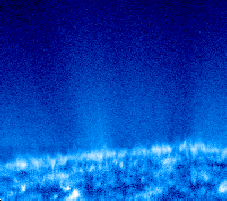SUMER study #120: Polar plume in Mg X, C I, N V
- date, time: 27.Jan.96, 19:05 - 21:36 UT
- field of view: 113 arcsec E - 113 arcsec W, 925 arcsec N - 1225 arcsec N
- slit: 1.0 arcsec x 300 arcsec (number 2)
- raster step size: 1.13 arcsec (3 elementary steps)
- exposure time: 45 seconds
- telemetry: 3(lines)*201 images of 50 spectral x 360 spatial pixels
(format 8)
- compression: quasilog-min-max (method 5)
- wavelengths:
1253.47 Å on reference pixel 163 of Detector A
1242.80 Å on reference pixel 407 of Detector A
609.794 Å on reference pixel 939 of Detector A
- rotation compensation: standard
- binning: no spectral, no spatial
- on-board flat field correction: no
Remarks: Since the study was executed early in the commissioning phase,
the real field-of-view coordinates may not be as commanded.
There was an
earlier version
of this page without north-south orientation correction.
 Mg X (corona, 1 100 000 K)
Mg X (corona, 1 100 000 K)
 N V (transition region, 180 000 K)
N V (transition region, 180 000 K)
 S II (upper chromosphere, 25 000 K)
S II (upper chromosphere, 25 000 K)
 H I Ly a (chromosphere, 20 000 K)
H I Ly a (chromosphere, 20 000 K)
 C I (lower chromosphere, < 10 000 K)
C I (lower chromosphere, < 10 000 K)
Detailed information
Spectral windows and images can be found for
Images show the subtracted background intensity (in this case, more or less
the wing of Lyman alpha), line intensity, shift and width. Information on Mg X
and C I is incomplete, because the line signal is noisy and possibly blended.
Animation
To see an animation of the different stages of the Solar atmosphere as recorded
by this SUMER study, download the IDL/XDR restore file
PP27JAN_MOVIE_XDR.RST
(334 KB) and the short IDL program
PP27JAN_MOVIE.PRO.
After starting the animation with
IDL> .run pp27jan_movie
the images will go through the five different stages (C I, H I Ly a, S II, N V,
Mg X) up and down "like an elevator".
IED, 05.Nov.98
 Mg X (corona, 1 100 000 K)
Mg X (corona, 1 100 000 K) N V (transition region, 180 000 K)
N V (transition region, 180 000 K) S II (upper chromosphere, 25 000 K)
S II (upper chromosphere, 25 000 K) H I Ly a (chromosphere, 20 000 K)
H I Ly a (chromosphere, 20 000 K) C I (lower chromosphere, < 10 000 K)
C I (lower chromosphere, < 10 000 K)
 Mg X (corona, 1 100 000 K)
Mg X (corona, 1 100 000 K) N V (transition region, 180 000 K)
N V (transition region, 180 000 K) S II (upper chromosphere, 25 000 K)
S II (upper chromosphere, 25 000 K) H I Ly a (chromosphere, 20 000 K)
H I Ly a (chromosphere, 20 000 K) C I (lower chromosphere, < 10 000 K)
C I (lower chromosphere, < 10 000 K)